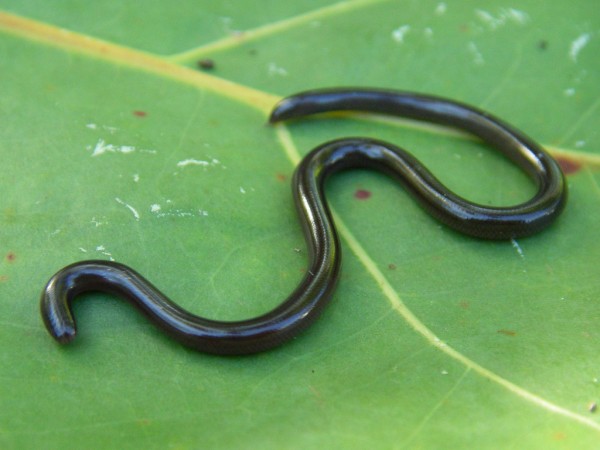Marine biology major has snakes on the brain
A blind snake species, Ramphotyphlops Braminus, variously known as the brahminy blind snake, flowerpot snake and island blind snake lives mostly underground and is often mistaken for an earth worm. Among the scientific community, there is a well-known hypothesis that the eyes of these harmless snakes contains severely regressed retinas. Kathryn Gallman, a marine biology major, was intrigued by the species and wanted to dig deeper into the subject. To pursue her research, she needed to analyze a brain atlas of the snake and quickly realizing that it was uncharted territory.
During her research, Kathryn came across a species that also maintained a subcutaneous eye. A study on blind mole rats (Cooper 1993) concluded that the mole essentially lost all retinal and brain components of vision while still preserving their non-visual light detection ability. This sparked Kathryn’s curiosity on whether similar structures could be present in reptiles, specifically snakes.
“The overall goal of my research is to identify the sites of retinal projection in the snake’s brain,” says Kathryn. She explained that this would be for comparative analysis of the evolution of visual and non-visual photoreceptive systems.
“The suprachiasmatic nucleus is the part of the brain in mammals that receives non-visual photoreception input and is responsible for the regulation of biological clocks, such as a circadian rhythms,” she says.
The Situation
The tropical blind snake has many unique characteristics, including being asexual, all-female species. While most researchers have focused their efforts on these unique qualities, essentially nothing is known about its eyes and brain. Like the mole rat, the snake maintains small subcutaneous eyes located underneath the skin and scales that have been contributed to the adaptation of the organism to a subterranean environment.
“Because snakes lived mostly underground following their differentiation from lizards,” says Kathryn, “their ocular structures degenerated to allow energy conservation to more vital structures for life in a subterranean habitat.”
When snakes resumed living above ground, they were forced to recreate their eyes from these severely degraded ocular structures. This is what primarily made their visual architecture unique among many other animal species.
Kathryn’s study provided an opportunity to study photoreception pathways in ancestral snake species with a simplified brain architecture that can be attributed to its small size; however, this minute size gave rise to a variety of challenges.
Facing the Challenge
“Mapping a brain with a width about the size of the tip of your pen required the development of a procedure that could be adapted to a very precise scale,” says Kathryn. “Months of microtome head sectioning, and dyeing with Azure Blue II produced poor images that left much of the brain unidentifiable.”
She was able to solve this problem and identify the brain’s architecture by dyeing a cryosectioned head with cresyl violet, a stain specific to neural tissue. Next, she injected a neural tract-tracing compound into an eye the size of a speck of dust.
Despite these challenges, Kathryn bestows the crown of “Greatest struggle faced through the course of this project” on simply obtaining the snakes. The small size and dark coloration make this organism difficult to locate when sifting through soil, and even when located, it is often mistaken for a worm.
“I spent much of last summer unsuccessfully combing Brevard for these tiny snakes and am therefore forever grateful to the individuals who helped provide specimens for my research,” she admitted.
Her hard work paid off and she took home best in show for biological sciences during this year’s Northrop Grumman Engineering and Science Design Showcase.
Breakthrough and Retrospect
Kathryn reflects that the most interesting discovery made through the course of this research was that the snake possesses a fully structured retina. “The existence of such structural organization in a non-subcutaneous eye would indicate the capability of image formation and this poses many possibilities for both the level of light processing in this organism and the evolution of snake ocular structures,” she explained.
Having now completed the research, Kathryn has a lot of insight on what she would do differently. She muses that given the mandate to start the study anew, her first step would be to focus her research on a more easily obtainable organism.
“The difficulty in acquiring specimen for research greatly elongated the timeline of the project, since most of the time was spent searching for snakes,” she says.
“While this organism is both fascinating and requires a much smaller budget due to the small amount of chemicals necessary to react with a minutely sized head,” she continues, “collecting samples proved to be an unforeseen detriment to productivity and made my undergraduate research unnecessarily difficult.”
With the satisfaction of having finished the study, Kathryn has honed various skills that will be essential in the career she intends to pursue. “I learned a variety of tissue staining sectioning techniques otherwise unavailable to an undergraduate student,” she says.
Marine Biology Major has Major Decision
Kathryn began the project as a marine biology major, and now faces a difficult decision with regards to graduate school after her deep immersion in retinal biology and neurobiology. The experience opened a whole new area of interest to which she would otherwise have been unexposed.
Kathryn also learned that any invasive invertebrate research requires both IACUC approval and separate certification levels to ensure appropriate levels of animal care and maintain institution accreditation. “This certification is something that I can take with me to other research institutions to perform similar vertebrate research,” she says.
The topic of her research helped Kathryn grow as a research scientist and her advice to future design presenters is to choose a topic they can get excited about. “Your excitement regarding your research is contagious and the judges will recognize this, as well as the resulting amount of effort that went into the study,” she says.
The Underlying Discovery
“The main takeaway from this experience for me was that research is both extremely difficult and time consuming,” Kathryn admitted. “This may seem obvious to some, but I never anticipated the amount of time and effort that goes into a project before any sort of breakthrough occurs.”
“I learned that research requires a lot of diligence and patience, and that results do not occur directly following the first trial, but after many frustrating attempts,” she says. “The biggest motivator for me was to not give up if success wasn’t immediate; that it takes the right combination of people, perseverance and ideas to achieve results.”





